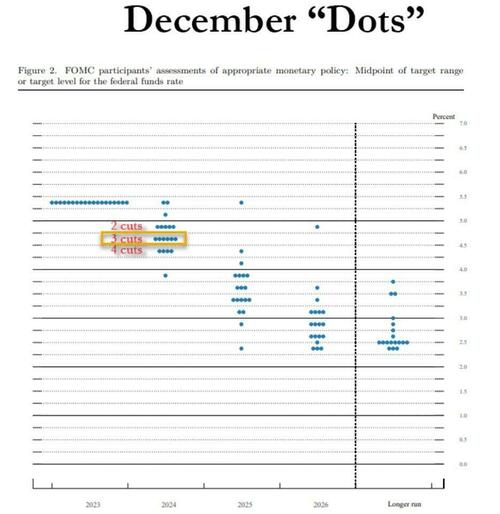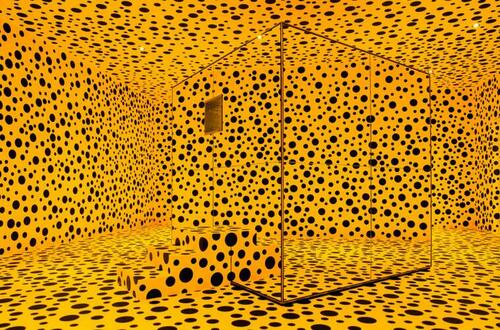The Fed’s “Dot Plot” Will Look Like A Meaningless, Infinite Polka-Dot Installation
By Michael Every of Rabobank
As expected, the RBA left rates on hold at 4.35%, but provided succor in replacing a tightening bias with “not ruling anything in or out.” That leaves a lot to the imagination of those who have mortgages, and/or would like house prices to continue to make them multi-millionaires without having to do any work. However, as our Ben Picton noted, the RBA added rates are only “slightly” restrictive, which implies a neutral rate only slightly lower than 4.35%. Moreover, it thinks unemployment, now 4.1%, needs to rise to 4.5% before the labor market is back in balance, and Ben thinks the re-regulation seen there of late means it might have to be as high as 5%: without that, it’s hard to see how the RBA’s assumption that sluggish productivity growth picks up again, and torrid wages growth slows down can be simultaneously achieved. Overall, Ben still thinks rates are on hold until November, and we only get two 25bp cuts in total.
The BOJ’s tiny rate hike and end to negative rates, yield curve control, and buying ETFs didn’t go quite as planned. Bond buying will continue (yes, “Rate hikes and QE”), and no timeline for any further BOJ action saw JPY drop past the 150 level. That underlines all the Fed has to do now is to be less dovish than everyone else, and the dollar will remain well bid (vs. other fiat at least). Yet at the same time, Bloomberg quotes two Japanese research houses who suspect the BOJ will actually need to do far more: they talk of an end-point policy rate of 2% and 2.5%.
The last time we saw that was September 1993, close enough to the end of the first Cold War to have symmetry with the recognition that we are now deep into a second one – with nasty hot flushes. On which note, Russia’s TASS news service was yesterday claiming France is ready to send 2,000 soldiers to Ukraine, which Paris has denied.
But today is all about the Fed’s dot-plot, where we are not looking at US consumer, but Kusuma sentiment. (Yayoi Kusuma being the doyenne of dot-based art who looks like Janet Yellen on the magic mushrooms she tried in China.)
RBA-style, nobody expects the Fed to do anything on rates; but everybody will look for what they might do later in their updated dots. BOJ-style, we may even see some pockets of speculation about decades-long precedent-breaking scenarios, such as a higher neutral rate – although I expect there will be very sharp disagreement within the Fed over that.
Headline US CPI says it would be silly to cut rates ahead; so does core CPI; and core services CPI; and PPI; and monthly payrolls; and weekly initial jobless claims; and house prices, if you don’t want them to rise further; and the trend in energy prices, where our team have just revised their projections for Brent higher again; and the trend in copper (and cocoa!); and US stocks, or at least anything AI related; and financial conditions; and gold; and Bitcoin, now larger than silver in terms of market capitalisation, which was historically long day-to-day money for many. On the other hand, we have questions over data quality; weak ISM surveys, especially the employment indices; weak industrial production; ‘meh’ retail sales; signs of consumer stress; worries over commercial real estate; and recognition that the US train only keeps rolling due to fiscal stimulus that will eventually go off the rails. That already makes for a difficult Fed debate and forward-looking decision-making process. On balance, it points to some moderate tweaks lower in Fed Funds later this year, as our Fed strategist Philip Marey has been saying since last year.
However, the real complexity comes further down the track. How does the above dynamic play out?
- What if Joe Biden wins re-election, keeps the fiscal taps open, and embraces more populist trade policies?
- What if Donald Trump wins re-election, keeps the fiscal taps open, and imposes 10-100% tariffs on various products?
- How do other central banks respond to either?
- How does geopolitics respond?
- And then how does the Fed respond?
No Fed economist can compute all of the above binaries, and uncertainties, and certain uncomfortable certainties, to give an accurate reading on future US and global growth and inflation.
The truth is the potential map of future dot plots looks like Kusuma’s ‘Infinite Polka-dots Instillation’, and the average of that –which the market will try to look to today– is going to be essentially meaningless.
However, as noted, Philip is plotting his own course, making clear that if we get more US protectionism after November 2024, the Fed will be forced to pause in 2025. In other words, potentially the Fed path might not be that far off the RBA; in which case, what is the pressure then like on the BOJ and others, like the ECB?
Following the Fed, we also get a policy decision in Brazil, where the Selic Rate is seen coming down 50bp from 11.25% to 10.75%. That’s ahead of a rate decision in Mexico tomorrow, where they are likely to cut rates 25bp to 11.0%, and as Bloomberg notes that some EM curves are starting to diverge from that of the US. You don’t need to join too many dots to know how that can sometimes end up, historically. Dot. Dot. Dot.
As we wait for that Fed decision, let me close with another link between Kusuma and institutional economic thinking. Both take simple ideas (‘dots’; or ‘tax cuts’, etc.) and stretch them ad nauseum, ad ridiculum to become their entire careers. Yet they make millions by doing so, even it all bears no resemblance to the real world. How dotty is that?
Tyler Durden
Wed, 03/20/2024 – 11:05
via ZeroHedge News https://ift.tt/WFv3IfY Tyler Durden

